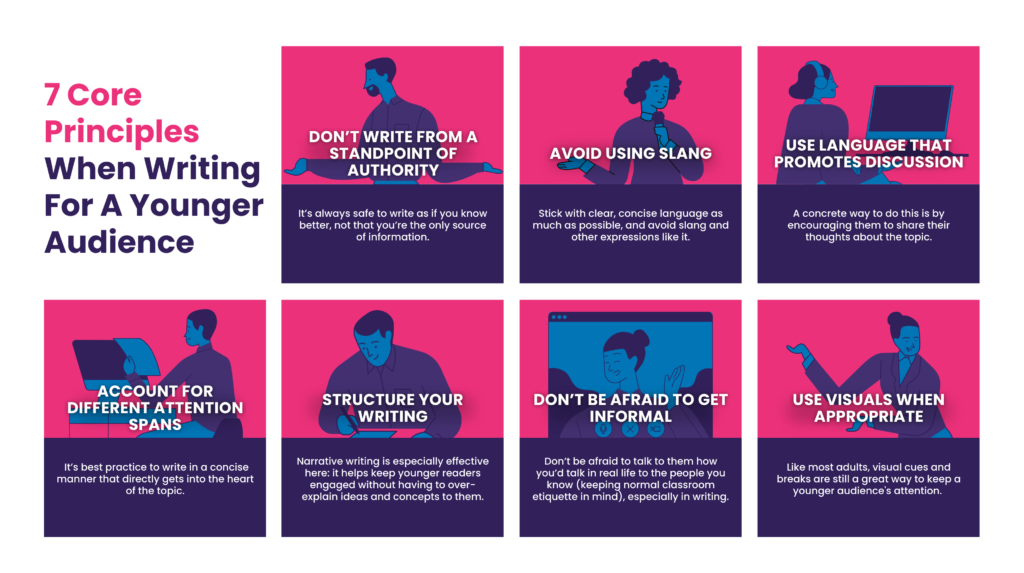Menu

As an educator, your communication with your students can decide how much they’ll learn in your learning environment. But guaranteeing smooth communication (especially with written material) can be a challenge for older teachers.
The issue isn’t so much that there isn’t anything worth teaching or that they’re difficult to teach. That’s just the nature of language: it changes in response to trends, technology, or simply because of a variety of seemingly unrelated factors.
However, that doesn’t make the entire process a wash: it just means you’ll have to write a little better to get your message across. Here’s how you do it.
Keep in mind that the specifics of the writing that you’ll do will depend on what the subject matter is and the overall maturity of your audience compared to you. However, these are the core principles that you need to keep in mind when writing:

This isn’t a dig at the entire “young people disrespect authority” trope – rather, it’s a conscious acknowledgment of the limits of what your experience is as a teacher. Sure, you may start off your dynamic as someone your students can learn from. But as much as possible, avoid writing from a perspective of authority.
In this case, “authority” can be defined as someone who thinks they’re the be-all and end-all of all information that someone needs to know, which can be a tendency that teachers (especially older ones) can be prone to. When in doubt, it’s always safe to write as if you know better, not that you’re the only source of information that your students should trust or learn from.
Ever wonder why younger audiences tend to cringe at adults using “modern” expressions? Most of the time, it’s because using these terms is a blatant attempt to try and connect with a younger audience. This doesn’t just feel forced – it can also seem disingenuous and patronizing.
Stick with clear, concise language as much as possible, and avoid slang and other expressions like it. Don’t worry about sounding dry or out of touch (there are several ways to overcome this, as we’ll discuss further), since what will matter in doing this is setting the tone of the entire exchange between teacher and student.
It’s impossible to account for different types of learners immediately when starting a class: some may feel comfortable reciting immediately while others rarely give feedback with the discussion at all. While this can definitely be the fault of the teacher, the way you communicate and write your learning materials also play a role.
When writing for a younger audience, you must use language that invites discussion, not shut it down. A concrete way to do this is by encouraging them to share their thoughts about the topic, rather than hyper-fixating on whether or not what they know is right or wrong.
Sometimes it’s easy to forget what a younger audience has to deal with when you’re viewing their lens as an adult. Physical development, social learning, and exposure to new ideas and concepts can be surprisingly draining on younger people – so as a result, their attention span can be significantly shorter compared to that of adults.
To account for this, it’s best practice to write in a concise manner that directly gets into the heart of the topic. Resist the urge to over-explain an idea: it’s far more engaging for them to be presented with the heart of a subject and then discuss the specifics with you. This not only makes your writing read better but saves the overall time and effort needed to internalize it.
There’s a reason the “introduction-body-conclusion” model works for many types of content. Younger audiences may not have the interest or perspective needed to infer context from the subtext, so it’s far better to structure your writing around a framework that’s easy to follow. Narrative writing is especially effective here: it helps keep younger readers engaged without having to over-explain ideas and concepts to them.
Structured writing also trains your audience in what to expect with your lessons and react accordingly. With enough time and familiarity with this framework, they’ll develop the agency to act on their own with your lessons, which makes for a richer and more engaging learning environment.
There’s a time and place for formal speech and writing – and the vast majority of classroom activities and teaching opportunities won’t need formalities at all. Above all else, an educator should encourage dialogue. Once you’ve managed to engage a younger audience to talk, you’ll soon find out that it’ll be harder to get them to stop.
Don’t be afraid to talk to them how you’d talk in real life to the people you know (keeping normal classroom etiquette in mind), especially in writing. Being candid is an easy way to do this, especially with young adults.
Writing for a younger audience doesn’t mean throwing an entire block of text at them: like most adults, visual cues and breaks are still a great way to keep their attention. If you find something like an image, infographic, or video that can clearly explain your idea, don’t be afraid to integrate it into your writing.
Fill in the space with your own thoughts and comments about the subject, perhaps expounding on the core idea of the visual aid. This plays into the entire concept of engaging with your students outside of your writing, but it also helps to create good pacing for your lessons and learning materials.
The key thing to keep in mind when writing for a younger audience is that your perspective will never be the same as theirs, no matter how much you try to study them from afar. While you may be older, it doesn’t necessarily guarantee that you’d be better at communication - but it does mean that you have more flexibility in delivering your message.
Simply put: being older gives you more of a foundation to start from when you write for a younger audience. By trimming that foundation down to the core essentials and then framing it through their potential experiences, you’re able to cover the basics of what’s needed to write better for a younger audience as an adult.
